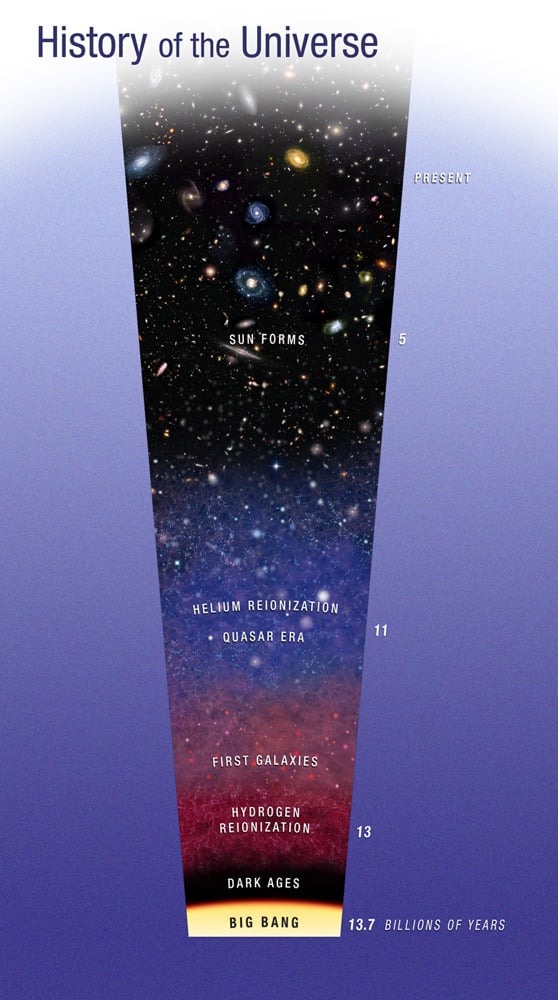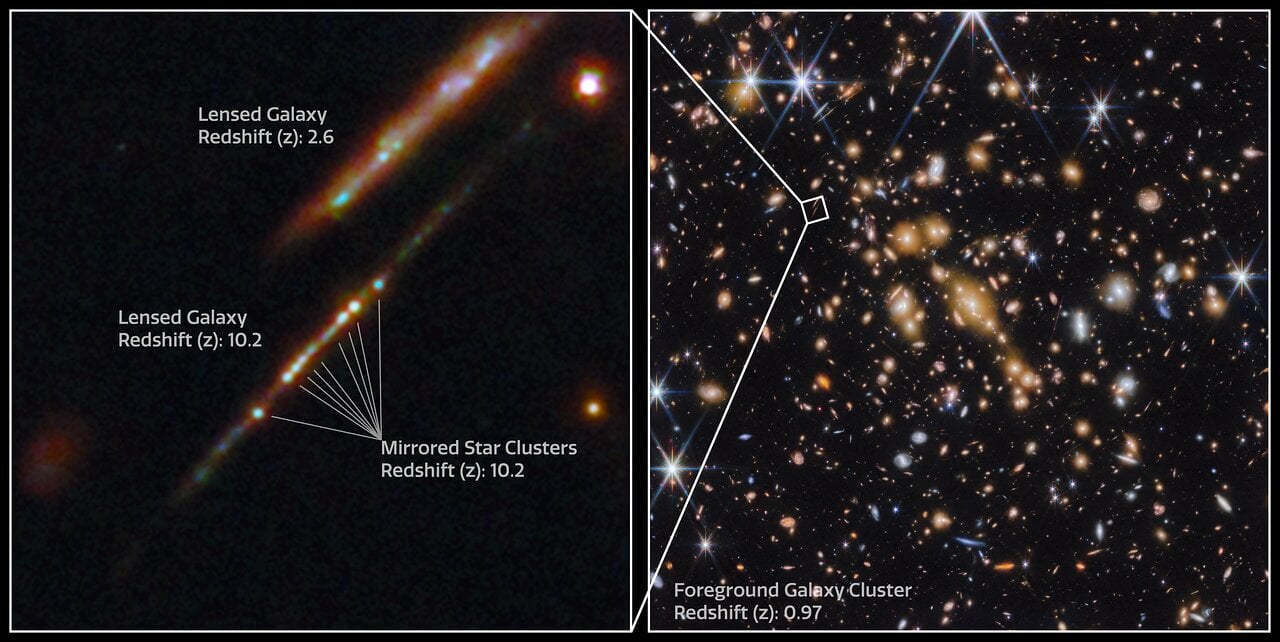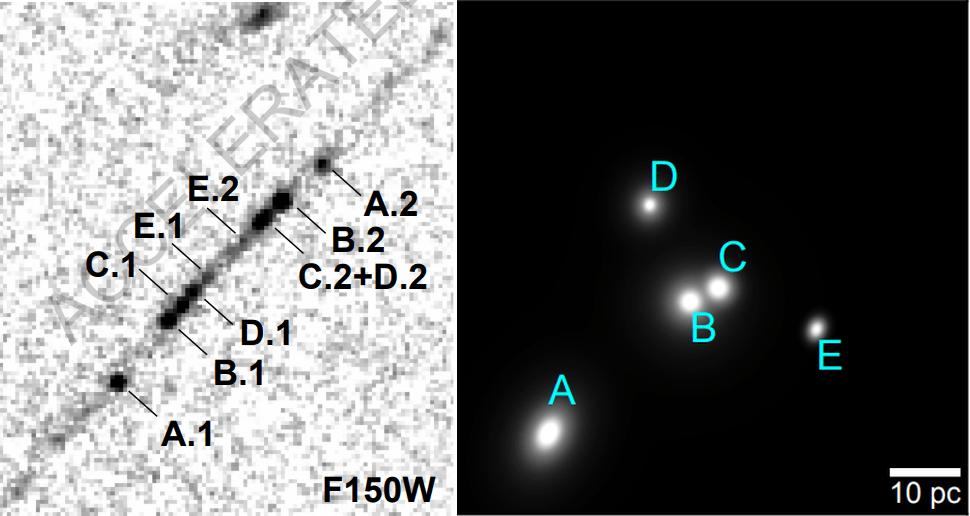Picture the Universe's ancient beginnings. In the vast darkness, light was emitted from a particular galaxy only 460 million years after the Big Bang. On the way, the light was shifted into the infrared and magnified by a massive gravitational lens before finally reaching the James Webb Space Telescope.
The galaxy is called the Cosmic Gems arc, and it held some surprises for astronomers.
Ancient, infant galaxies like the Cosmic Gems are extraordinarily difficult to observe. The light from the ancient galaxy is not only dim but stretched into the infrared by the expansion of the Universe. But this is exactly why NASA—and the European Space Agency and the Canadian Space Agency—built the powerful JWST infrared telescope: to look back in time and probe the Universe's beginnings.
To be clear, the JWST doesn't literally "look back in time." What it does is sense information from an ancient object that is now only reaching us. The information is light, and the nature of that light tells us about the state of that object when it emitted the light.
In this case, the JWST needed the help of a massive foreground galaxy cluster lined up just right to gather the light. So, the JWST's observations of the Cosmic Gems arc is both intentional and serendipitous.
The results of these observations are published in a paper titled " Bound star clusters observed in a lensed galaxy 460 Myr after the Big Bang. " It appears in the journal Nature, and the lead author is Angela Adamo, an Associate Professor in the Department of Astronomy at Stockholm University.
"It was incredible to see the JWST images of the Cosmic Gems arc and realize that we were looking at star clusters in such a young galaxy."Angela Adamo, Department of Astronomy, Stockholm University
Thanks to the JWST and gravitational lensing, this is the first time that astronomers have been able to see this much detail in an ancient galaxy from the Universe's Epoch of Reionization (EoR). The EoR is sometimes called the Cosmic Dawn because as the energy from the first stars and galaxies ionized hydrogen, light was allowed to travel through the young Cosmos. It had other effects, too, because it heated the Universe's hydrogen. This heated hydrogen biased the formation of objects towards larger ones. Heated hydrogen is more difficult to attract, so smaller galaxies were, in a sense, stifled. They didn't have enough mass to attract as much heated hydrogen as more massive galaxies.
For these and other reasons, scientists are interested in the EoR and how it shaped the Universe we see around us.
The JWST images of the Cosmic Gems arc revealed the presence of five massive young star clusters. "The surprise and astonishment was incredible when we opened the JWST images for the first time," said lead author Adamo in a press release.
The clusters are younger than 50 million years old and packed into a region smaller than 70 parsecs (~230 light-years). They have low metallicity and exhibit minimal dust attenuation. Each cluster has a mass of about 106solar masses and a size of about one parsec (3.24 light-years). But they contain more stars than a typical cluster, with three times the stellar density. Are these young globular clusters?
"Despite the uncertainties inherent to the lensing model, they are consistent with being gravitationally bound stellar systems, i.e., proto-globular clusters (proto-GCs)," the authors write in their paper.
"It was incredible to see the JWST images of the Cosmic Gems arc and realize that we were looking at star clusters in such a young galaxy. We observe globular clusters around local galaxies, but we don't know when and where they formed. The Cosmic Gems arc observations have opened a unique window for us into the works of infant galaxies as well as showing us where globular clusters formed," says Adamo. "These clusters will have enough time to relax and become globular clusters due to them being formed at such a young age of the Universe," she adds.
Globular clusters are some of the most fascinating and ancient objects in the Universe. Their stars tend to be old and have low metallicities. They formed long ago and no longer form new stars. They can contain as little as a few tens of thousands of stars up to many millions. Astronomers find globulars in almost every galaxy, and the Milky Way contains at least 150 globulars, mostly in the galactic halo.
There are outstanding questions about globulars, and their role in the evolution of galaxies is unclear. They're like fossils from the early Universe, but astronomers haven't unlocked all of their secrets.
Other star clusters have more uniform populations, with close ages and metallicities, but globulars don't always adhere to that. They have varying chemical abundances and ages, though none of their members are young. Some globulars, like the ones studied in the Large Magellanic Cloud, have bimodal populations. Astronomers think one portion of the stars formed from the same molecular cloud, but later, the cluster encountered another cloud and a second population was formed. But all observed clusters have one thing in common: they no longer form new stars.
There is some controversial evidence that GCs hold the elusive intermediate-mass black holes (IMBHs), another hint that they play a key role in galactic evolution. Unfortunately, though the evidence is tantalizing, not everyone agrees that they do hold IMBHs. There's also evidence that some GCs hold a number of stellar-mass black holes, but the picture isn't clear yet.
A tempting conclusion is pretty clear: if huge galaxies like ours have 150 GCs, and if GCs have either IMBHs or a cluster of stellar-mass black holes in their centers, then they appear every bit like galactic building blocks. But how does it all work?
While this research doesn't answer all of astronomers' questions about GCs, merely finding them in their nascent state only 460 million years after it all started is an important step.
 Universe Today
Universe Today



